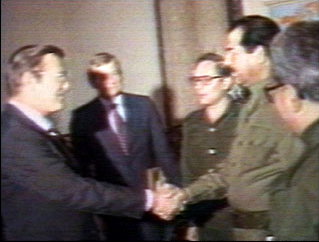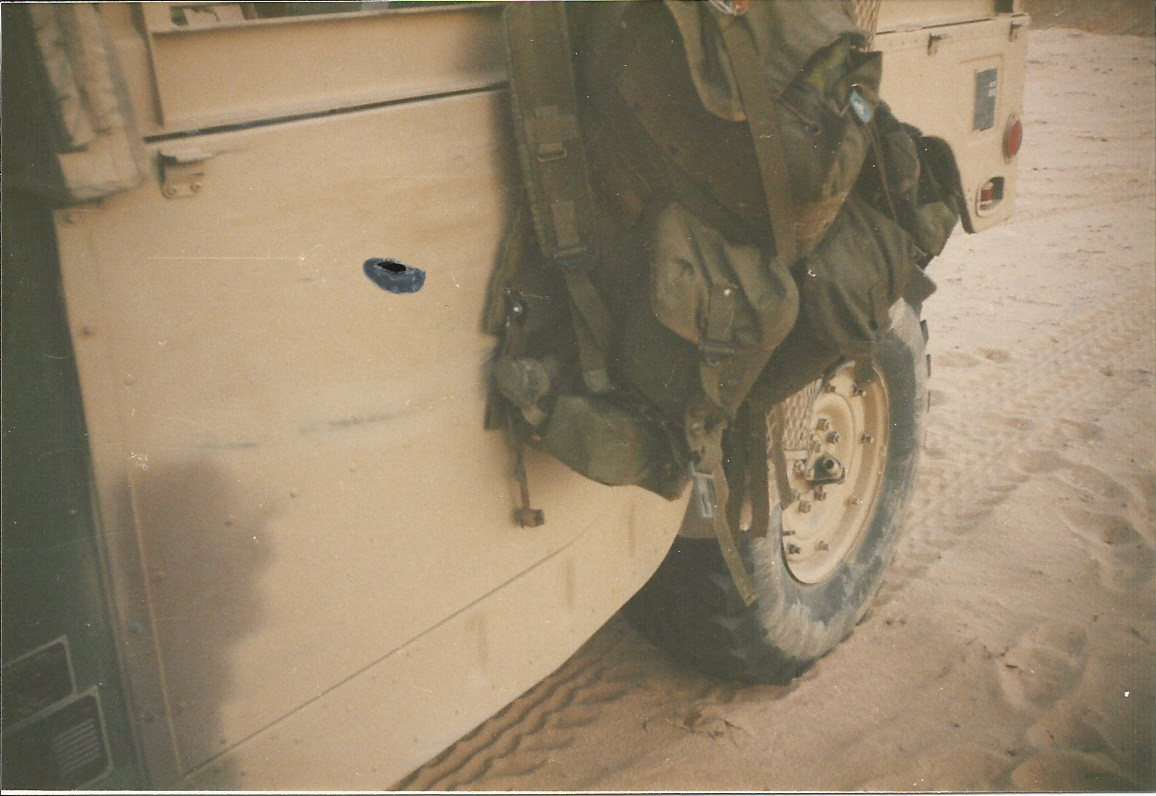|
Kuwait–Saudi Arabia Border
The Kuwait–Saudi Arabia border is 221 km (137 mi) in length and runs from the tripoint with Iraq in the west to the Persian Gulf coast in the east. Description The border starts in the west at the tripoint with Iraq on the Wadi al-Batin; a straight line of 90 km (55 mi), angled slightly to the south-east, then proceeds eastwards. The border then turns southwards via a series of irregular lines, before turning sharply to the east, with a straight line of 70 km (43 mi) running to the Gulf coast. History Historically there was no clearly defined boundary in this part of the Arabian peninsula; at the start of the 20th century the Ottoman Empire controlled what is now Iraq and United Kingdom, Britain controlled Kuwait as a Anglo-Kuwaiti Agreement of 1899, protectorate, with the interior consisting of loosely organised Arab groupings, occasionally forming emirates, most prominent of which was the Emirate of Nejd and Hasa ruled by the al-Saud family.Madawi Al-Rasheed. ' ... [...More Info...] [...Related Items...] OR: [Wikipedia] [Google] [Baidu] |
Tripoint
A triple border, tripoint, trijunction, triple point, or tri-border area is a geography, geographical point at which the boundaries of three countries or Administrative division, subnational entities meet. There are 175 international tripoints as of 2020. Nearly half are situated in rivers, lakes or seas. On dry land, the exact tripoints may be indicated by markers or pillars, and occasionally by larger monuments. Usually, the more neighbours a country has, the more international tripoints that country has. China with 16 international tripoints and Russia with 11 to 14 lead the list of states by number of international tripoints. Other countries, like Brazil, India, and Algeria, have several international tripoints. Argentina has four international tripoints. South Africa, Pakistan and Nigeria have three international tripoints, Guatemala has two: one with Mexico and Belize, and one with Honduras and El Salvador; while Bangladesh and Mexico have one. Within Europe, landlocked Au ... [...More Info...] [...Related Items...] OR: [Wikipedia] [Google] [Baidu] |
Ibn Saud
Abdulaziz bin Abdul Rahman Al Saud (; 15 January 1875Ibn Saud's birth year has been a source of debate. It is generally accepted as 1876, although a few sources give it as 1880. According to British author Robert Lacey's book ''The Kingdom'', a leading Saudi historian found records that show Ibn Saud in 1891 greeting an important tribal delegation. The historian reasoned that a 10 or 11-year-old child (as given by the 1880 birth date) would have been too young to be allowed to greet such a delegation, while an adolescent of 15 or 16 (as given by the 1876 date) would likely have been allowed. When Lacey interviewed one of Ibn Saud's sons prior to writing the book, the son recalled that his father often laughed at records showing his birth date to be 1880. Ibn Saud's response to such records was reportedly that "I swallowed four years of my life." p. 561" – 9 November 1953), known in the Western world as Ibn Saud (; ''Ibn Suʿūd''),''Ibn Saud'', meaning "son of Saud" (see Arabi ... [...More Info...] [...Related Items...] OR: [Wikipedia] [Google] [Baidu] |
Borders Of Kuwait
A border is a geographical boundary. Border, borders, The Border or The Borders may also refer to: Arts, entertainment and media Film and television * ''Border'' (1997 film), an Indian Hindi-language war film * ''Border'' (2018 Swedish film), a fantasy film * ''Border'' (2018 Bhojpuri film), an Indian Bhojpuri-language war film * ''The Border'' (1982 film), an American drama * ''The Border'' (1996 film), an Italian war drama * ''The Border'' (2007 film), a Finnish-Russian war drama * ''The Border'' (2009 film), a Slovak documentary * ''The Border'' (2008 TV series) a 2008–2010 Canadian drama series * ''The Border'' (2014 TV series), a 2014–2020 Polish crime series Literature * "The Border", a 2004 short story by Richard Harland * "The Border", a 2019 novel by Don Winslow Music * "Border" (song), by Years & Years, 2015 * "Borders" (Feeder song), 2012 * "Borders" (M.I.A. song), 2015 * "Borders" (The Sunshine Underground song), 2007 * ''The Border'', soundtrack ... [...More Info...] [...Related Items...] OR: [Wikipedia] [Google] [Baidu] |
Kuwait–Saudi Arabia Border
The Kuwait–Saudi Arabia border is 221 km (137 mi) in length and runs from the tripoint with Iraq in the west to the Persian Gulf coast in the east. Description The border starts in the west at the tripoint with Iraq on the Wadi al-Batin; a straight line of 90 km (55 mi), angled slightly to the south-east, then proceeds eastwards. The border then turns southwards via a series of irregular lines, before turning sharply to the east, with a straight line of 70 km (43 mi) running to the Gulf coast. History Historically there was no clearly defined boundary in this part of the Arabian peninsula; at the start of the 20th century the Ottoman Empire controlled what is now Iraq and United Kingdom, Britain controlled Kuwait as a Anglo-Kuwaiti Agreement of 1899, protectorate, with the interior consisting of loosely organised Arab groupings, occasionally forming emirates, most prominent of which was the Emirate of Nejd and Hasa ruled by the al-Saud family.Madawi Al-Rasheed. ' ... [...More Info...] [...Related Items...] OR: [Wikipedia] [Google] [Baidu] |
Ahmadi Governorate
The Ahmadi Governorate is a Governorates of Kuwait, governorate in southern Kuwait. It is the second most populated governorate in Kuwait, behind Farwaniya Governorate. Many oil and petroleum companies such as Kuwait Oil Company, KOC and Kuwait National Petroleum Company, KNPC have their headquarters here. Districts Ahmadi consists of the following districts: Government Jabir Abdallah Jabir Abdallah II served as governor 1962–1985. Under a June 2024 Amiri decree, Amiri Decree, Homoud Jaber Al-Ahmed Al-Sabah was appointed the governor of Al-Ahmadi for a four year mandate. Notes References {{Authority control Governorates of Kuwait Ahmadi Governorate ... [...More Info...] [...Related Items...] OR: [Wikipedia] [Google] [Baidu] |
Jahra Governorate
Jahra Governorate ( ) is one of the six governorates of Kuwait. It is the largest Governorate in Kuwait accounting for 63 percent of its land area. It includes the town of Al Jahra, most of the northern and western parts of Kuwait, several islands (among them Bubiyan Island). and also western districts of Kuwait City. It also contains most of Kuwait's arable land. Al Jahra also has some historic relevance to Kuwait's history. The Red Palace is the most important historical landmark there. Historically, Al Jahra was an agricultural oasis village and most locals were farmers. Al Jahra's most notable residents included Sheikh Thuwainy Bin Abdullah Al-Saadoun of Al-Muntafiq in 1786, when he fled from Baghdad to Suleiman Pasha. He wanted to occupy Basra and Sheikh Abdullah Al-Sabah hosted him until he returned to Baghdad Baghdad ( or ; , ) is the capital and List of largest cities of Iraq, largest city of Iraq, located along the Tigris in the central part of the country. ... [...More Info...] [...Related Items...] OR: [Wikipedia] [Google] [Baidu] |
Gulf War
, combatant2 = , commander1 = , commander2 = , strength1 = Over 950,000 soldiers3,113 tanks1,800 aircraft2,200 artillery systems , page = https://www.govinfo.gov/content/pkg/GAOREPORTS-PEMD-96-10/pdf/GAOREPORTS-PEMD-96-10.pdf , strength2 = 1,000,000+ soldiers (~600,000 in Kuwait)5,500 tanks700+ aircraft3,000 artillery systems , casualties1 = Total:13,488 Coalition:292 killed (147 killed by enemy action, 145 non-hostile deaths)776 wounded (467 wounded in action)31 tanks destroyed/disabled28 Bradley IFVs destroyed/damaged1 M113 APC destroyed2 British Warrior APCs destroyed1 artillery piece destroyed75 aircraft destroyedKuwait:420 killed 12,000 captured ≈200 tanks destroyed/captured 850+ other armored vehicles destroyed/captured 57 aircraft lost 8 aircraft captured (Mirage F1s) 17 ships sunk, 6 captured. Acig.org. Retrieved on 12 June 2011 , casualties2 = Total:175,000–300,000+ Iraqi:20,000–50,000 killed ... [...More Info...] [...Related Items...] OR: [Wikipedia] [Google] [Baidu] |
Battle Of Khafji
The Battle of Khafji was the first major ground engagement of the Gulf War. It took place in and around the Saudi Arabian city of Khafji, from 29 January to 1 February 1991. Iraqi leader Saddam Hussein, who had already tried and failed to draw Coalition forces into costly ground engagements by shelling Saudi Arabian positions and oil storage tanks and firing Scud surface-to-surface missiles at Israel, ordered the invasion of Saudi Arabia from southern Kuwait. The 1st and 5th Mechanized Divisions and 3rd Armored Division were ordered to conduct a multi-pronged invasion toward Khafji, engaging Saudi Arabian, Kuwaiti, and U.S. forces along the coastline, with a supporting Iraqi commando force ordered to infiltrate further south by sea and harass the Coalition's rear. These three divisions, which had suffered significant losses from attacks by Coalition aircraft in the preceding days, attacked on 29 January. Most of their attacks were repulsed by U.S. Marine Corps and U.S. A ... [...More Info...] [...Related Items...] OR: [Wikipedia] [Google] [Baidu] |
Iraq–Saudi Arabia Border
The Iraq–Saudi Arabia border is 811 km (504 mi) in length and runs from the tripoint with Jordan in the west to the tripoint with Kuwait in the east. Description The border starts on the west at the tripoint with Jordan, and consists of six straight lines broadly orientated to the south-east, eventually reaching the tripoint with Kuwait on the Wadi al-Batin. History Historically there was no clearly defined boundary in this part of the Arabian peninsula; at the start of the 20th century the Ottoman Empire controlled what is now Iraq, with areas further south consisting of loosely organised Arab groupings, occasionally forming emirates, most prominent of which was the Emirate of Nejd and Hasa ruled by the al-Saud family.Madawi Al-Rasheed. ''A History of Saudi Arabia''. Cambridge, England, UK: Cambridge University Press, 2002. Pp. 40. During the First World War an Arab Revolt, supported by Britain, succeeded in removing the Ottomans from most of the Middle East. As ... [...More Info...] [...Related Items...] OR: [Wikipedia] [Google] [Baidu] |
Uqair Protocol Of 1922
The Uqair Protocol or Uqair Convention was an agreement at Uqair on 2 December 1922 that defined the boundaries between Mandatory Iraq, the Sultanate of Nejd and Sheikhdom of Kuwait. It was made by Percy Cox, the British High Commissioner to Iraq, in response to Ikhwan raiders from Nejd under Ibn Saud attacking Kuwait. Cox met ibn Saud and Major John More, the British Political Agent to Kuwait. The boundaries included a Saudi–Iraqi neutral zone and a Saudi–Kuwaiti neutral zone. Kuwait was not permitted any role in the outcome of the Uqair agreement when the Saudis and British decided Kuwait's modern boundaries. Kuwait lost more than two thirds of its territory as a result of the agreement, as well as its second largest town, the port of Manifa. The loss of territory made anti-British sentiment grow in Kuwait. See also * Iraq–Saudi Arabia border * Kuwait–Saudi Arabia border *List of Middle East peace proposals This is a reversed chronological list of peace propo ... [...More Info...] [...Related Items...] OR: [Wikipedia] [Google] [Baidu] |





